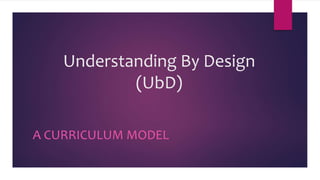
Understanding by design (ub d)
- 1. Understanding By Design (UbD) A CURRICULUM MODEL
- 2. The 3 Stages of UbD Stage 1: has something to do with results/desired outcomes. Results and desired outcomes are what students should be able to know and do the end of the unit. They are expressed in terms of overall goals and specifically defined in terms of content and performance standards.
- 3. Set targets 1. Intended results/ Desired outcomes • Content Standards – These refer to what student should know and be able to do • Performance Standards – These refer to the level of proficiency with which a student can demonstrate what he or she knows and what he or she can do.
- 4. 2. Essential Understandings – These are big and enduring ideas at the heart of the discipline which we want children to remember even long after they leave school. 3. Essential Questions – These are open-ended, provocative questions that spark thinking and inquiry into the essential meanings and understandings.
- 5. 4. Curriculum Objectives – These are expressed in terms of specific knowledge, skills and values which are expected to be taught and learned.
- 6. Stage 2: is an assessment Assessment refers to the acceptable evidence that the desired goal has been attained. This evidence maybe may be in the form of products and performances. This products and performances are the demonstration of conceptual understanding, content skill, and attitudes students learned.
- 7. Determine the evidence of Understanding There are 6 facets of Understanding. The learner’s understanding of what was learned can be exhibited by his or her ability to explain, interpret, apply, see what he or she learned from various perspectives, empathize with others and reflect how the lesson learned relates to himself or herself.
- 8. Learning Activities Using 6 Facets The six (6) facets of understanding are concretely illustrated with a lesson nutrition, shown below: TOPIC – Nutrition 1. Explanation. Develop a brochure to help younger students understand what is meant by a balance diet. 2. Interpretation. Discuss what the popularity of Fast food say about modern life. 3. Application. Plan a menu for a class party consisting of healthy yet tasty snacks.
- 9. Learning Activities Using 6 Facets 4. Perspective. Conduct research to find out if the food pyramid guidelines apply in other regions such as Antarctica, Asia, Middle East and the impact of diverse diets on health and longevity. 5. Empathy. Imagine how it might feel to live with a dietary restriction due to a medical condition. 6. Self-Knowledge. Reflect on the one can become extent a healthy eater?
- 10. Stage 3: spells out the details of the instructional activities that students will go through to attain the standards.
- 11. Plan Instruction This stage follows the following steps: Explore – find out what your students know and not know about the lesson Firm up – affirm the correct concepts or skills that they know. Correct what is erroneous. Teach what they do not know Deepen – the following strategies suggested: • Wait atleast 5 seconds of thinking time after a question and after a response.
- 12. • Call on students randomly • Use follow ups: Can you explain? Why? How do you know? • Ask for summaries • Surveys class: How many agree with ? • Encourage student questioning • Discussion with a partner
- 13. Apply/ Transfer – is the application of concepts, skills, and attitudes learned in real life.
- 14. WHERETO Framework This acronym is a proposed framework for developing an instructional plan. This can help you in stage 3 of UbD. W – How will I help learners know WHAT they will be learning? WHAT evidence will show their learning? H – How will I HOOK the learners? E – How will I EQUIP students to master identified standard? What learning EXPERIENCES will help deepen understanding.
- 15. WHERETO Framework R – How will I encourage learners to RETHINK previous learning? How will I encourage ongoing REVISION and REFINEMENT? E – How will I promote self-EVALUATION and reflection? T – How will I TAILOR my learning activities to address the different readiness levels, learning profiles of students? O – How will the learning experience be ORGANIZED to maximize engaging and effective learning?
- 16. Selection and Use of Instructional Materials
- 17. Principles For optimum learning let us observe the following general principles in the use of instructional materials (Ims). 1. All instructional materials are aids to instruction. They do not replace the teacher. 2. Choose the instructional materials that best suits your instructional objectives. 3. If possible, use variety of tools 4. Check out your instructional materials before class starts to be sure it is working properly
- 18. 5. For results, abide by the general utilization guide on the use of media given below: • Learn how to use instructional material • Prepare introductory remarks • Provide conductive environment
- 19. • Explain the objectives of the lesson • Stress what is to be watched or listened carefully • State what they will be expected to do with the information they will learn • There is a need to summarize or review the experience (More details on instructional materials will be discussed in Educational Technology 1)
